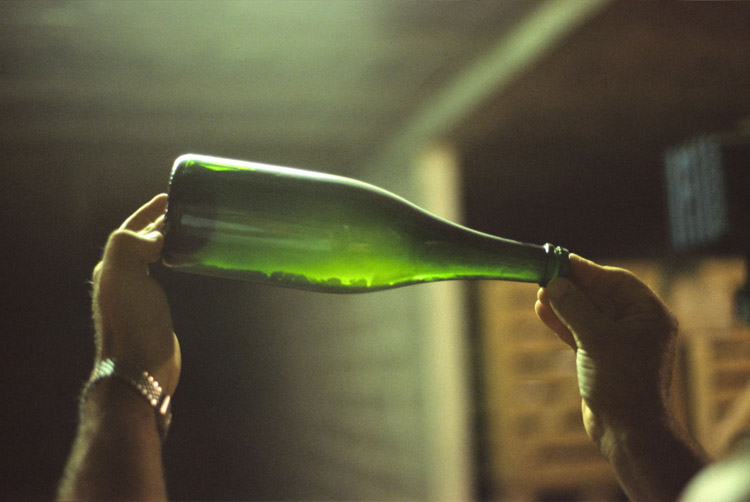Secondary fermentation (wine) on:
[Wikipedia]
[Google]
[Amazon]
 Secondary fermentation is a process commonly associated with
Secondary fermentation is a process commonly associated with
 In
In
Studies on the Secondary Fermentation of Low-Alcohol Sparkling Apple Wine
'' 44:1:93-98 (1993) *Jeff Cox ''"From Vines to Wines: The Complete Guide to Growing Grapes and Making Your Own Wine"'' Storey Publishing 1999 * SQ Liu '
Malolactic fermentation in wine - beyond deacidification
'' - Journal of Applied Microbiology, 2002 Volume 92 Issue 4 Page 589-601 *William Patton ''"The laws of fermentation and the wines of the ancients"'' University of Michigan Publishing 2005
Transfer to secondary
'' {{Wines Winemaking *
winemaking
Winemaking or vinification is the production of wine, starting with the selection of the fruit, its fermentation into alcohol, and the bottling of the finished liquid. The history of wine-making stretches over millennia. The science of wine and ...
,J. Robinson (ed) ''"The Oxford Companion to Wine"'' Third Edition pg 618 Oxford University Press 2006 which entails a second period of fermentation in a different vessel than the one used to start the fermentation process. An example of this would be starting fermentation in a carboy
A carboy, also known as a demijohn or a lady jeanne, is a rigid container with a typical capacity of . Carboys are primarily used for transporting liquids, often water or chemicals.
They are also used for in-home fermentation of beverages, ...
or stainless steel tank and then moving it over to oak barrels
Oak is used in winemaking to vary the color, flavor, tannin profile and texture of wine. It can be introduced in the form of a barrel during the fermentation or aging periods, or as free-floating chips or staves added to wine fermented in a vess ...
. Rather than being a separate, second fermentation, this is most often one single fermentation period that is conducted in multiple vessels. However, the term does also apply to procedures that could be described as a second and distinct fermentation period.
In wine production
 In
In sparkling wine production
Sparkling wine production is the method of winemaking used to produce sparkling wine. The oldest known production of sparkling wine took place in 1531 with the ''ancestral method''.
Pressure and terminology
In popular parlance and also in th ...
, the secondary fermentation often takes places in the wine bottle that the wine will be sold in. This is most commonly known as the ''méthode champenoise'' or " Champagne method" after the region
In geography, regions, otherwise referred to as zones, lands or territories, are areas that are broadly divided by physical characteristics ( physical geography), human impact characteristics ( human geography), and the interaction of humanity an ...
most noted for sparkling wine production. When the base wine (or '' cuvee'') has been produced from single grape
A grape is a fruit, botanically a berry, of the deciduous woody vines of the flowering plant genus '' Vitis''. Grapes are a non- climacteric type of fruit, generally occurring in clusters.
The cultivation of grapes began perhaps 8,000 years a ...
varietals or a blend, the wine is bottled with a mixture of yeast and fresh sugar known as the ''"liqueur de tirage"''. This secondary fermentation, also known as bottle fermentation, is the process that makes the wine "bubbly" due to the containment of carbon dioxide
Carbon dioxide ( chemical formula ) is a chemical compound made up of molecules that each have one carbon atom covalently double bonded to two oxygen atoms. It is found in the gas state at room temperature. In the air, carbon dioxide is t ...
which is normally released as a by product in regular fermentation.
In still wine production, particularly of red wines and some white wines like Chardonnay, the secondary fermentation process can also usher in the use of malolactic fermentation (or MLF) where the hard, green apple-like malic acid is converted into softer, butter-like lactic acid
Lactic acid is an organic acid. It has a molecular formula . It is white in the solid state and it is miscible with water. When in the dissolved state, it forms a colorless solution. Production includes both artificial synthesis as well as nat ...
. In the case of a stuck fermentation
A stuck fermentation occurs in brewing beer or winemaking when the yeast become dormant before the fermentation has completed. Unlike an "arrested fermentation" where the winemaker intentionally stops fermentation (such as in the production of ...
, a winemaker may wish to transfer the must to a second vessel and use stronger, more aggressive yeasts with high fermentation temperatures to re-initiate the fermentation process. A similar process known as '' governo'' has been used by Tuscan winemakers since the 14th century with the isolation after harvest of a batch of grapes that can be added later to the wine to help prevent (or recover from) a stuck fermentation.
See also
* Glossary of wine termsReferences
Further reading
* American Journal of Enology and Viticulture 'Studies on the Secondary Fermentation of Low-Alcohol Sparkling Apple Wine
'' 44:1:93-98 (1993) *Jeff Cox ''"From Vines to Wines: The Complete Guide to Growing Grapes and Making Your Own Wine"'' Storey Publishing 1999 * SQ Liu '
Malolactic fermentation in wine - beyond deacidification
'' - Journal of Applied Microbiology, 2002 Volume 92 Issue 4 Page 589-601 *William Patton ''"The laws of fermentation and the wines of the ancients"'' University of Michigan Publishing 2005
External links
* Winemaking basics 'Transfer to secondary
'' {{Wines Winemaking *